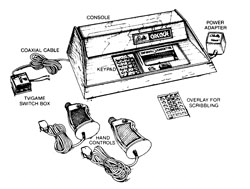Orphaned Computers & Game Systems
(Archive)
Vol. I, Issue 2 August 1994
Bally Astrocade:
A Step Ahead, Yet Still Behind

It is alternately referred to as the Bally Astrocade, the Bally Professional Arcade, and the Bally Arcade Videogame and Computer System. It doesn't really matter too much what you call it, because no matter how you slice it, this baby is one heck of a machine!
The Bally Astrocade was first advertised by a Chicago mail-order house in September/October of 1977. It was promised that it would be expandable in six weeks, so that it would become a complete computer system. The unit contains three microprocessors, a Z-80 CPU (which runs at 1.8 MHz), a video processor and an I/O handler. It also has three separate sound synthesizers.
In order to keep the unit down to its very low $300, the memory chips were seconds, and were prone to overheating. In fact, there is a large warning on the copy of my owner's manual that states, "Do not block vents by operating this unit on a carpeted surface. Heat build-up may result in component failure." From what I understand, that is an understatement. Many of these units were sent back to the manufacturer, because the memory chips had failed. I have used four different Bally units, and they get quite warm if used for even an hour or so.
Bally made many promises about upgrades to the system that never arrived. There were several typewriter-style keyboards released by third-party companies over the next few years, but most required RAM upgrades. A typewriter-style keyboard called the ZGRASS 1200 was released in limited quantities in 1983 by Astrovision (who bought the Bally unit in 1980). One promise did come through: In October of 1978, Bally released Tiny BASIC, a 4K, cartridge-based programming language.
Tiny BASIC is quite a good BASIC language, with one drawback: It could only access 1.8K of memory. Even if extra memory were added (third-party companies did release such items later), Tiny BASIC had no way to access it. Also, the original release of Tiny BASIC, which is now referred to as Bally BASIC, needed an additional tape adapter that plugged into joystick port #3. With the adapter, a program could be saved to any tape recorder at the speed of 300 baud. The method that is used to save programs is sort of awkward, and there is the chance of error.
In November of 1978, the first issue of the newsletter Arcadian was released. I have a complete collection of this monthly newsletter through October of 1984. If you are interested in programming the Bally at all, this newsletter is an essential, along with another newsletter called Cursor.
Astro Tiny BASIC was released in 1981, so that the Bally could be shipped as a complete unit for $300. The difference between Bally BASIC and AstroBASIC are small but quite significant. Astro was able to save to cassette at 2,000 baud, and has a much better line editor then the original Bally BASIC. The language remained pretty much the same, though. In order to load any previous programs that had been saved at 300 baud, you needed to use a special program that could be typed in from the new BASIC manual.
The Bally never really sold too well for several reasons, including poor planning and lack of available computer chips. Also, while Bally owned and marketed the unit, it was always put aside for more "important" projects. It wasn't even until Astrovision bought the unit in 1980 that it finally began to get the attention it deserved -- although, I must say, quite late.
Where Are the Games?
The Bally contains two built-in games, a calculator and a drawing program, all on an 8K ROM. The first game is called Gunfight, which is similar but superior to Atari's Outlaw. The second is Checkmate. It is just like Atari's Surround, except with better graphics (and up to four players can play at once). The drawing program, called Scribbling, is quite limited, and you are not able to save a drawing to cassette. The calculator performs just like a handheld unit.
Bally never released too many cartridge games for the system. It amazes me, though, how many games were released on cassette by third-party companies. Some of these games were quite good. The companies that released some of the better games were L&M, Bit Fiddlers, New Image and Esoterica. It should be noted that after these companies did well with cassettes, they went on to produce cartridges for the Bally as well.
The Bally Astrocade shall be the focus of a continuing column, which will appear as frequently as possible. At the moment, it is my favorite machine, except for the Atari 8-bit computers. In the future, I plan to review some of the harder-to-find cartridges, like Cosmic Raiders, Blast Droids, Ms. Candyman and many others. I will also be typing in several of the game programs from different newsletters, and will review the best of these public-domain games in a separate column.